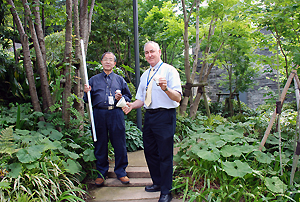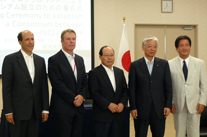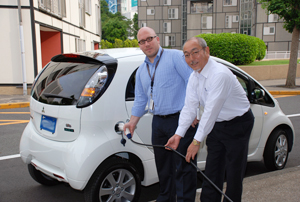Since Secretary of State Hillary Clinton launched the Greening Diplomacy Initiative in April 2009, the State Department has been leading by example in developing and implementing policies to minimize the environmental impact of its global operations. The “Green Team” of the U.S. diplomatic mission in Japan is involved in a variety of efforts aimed at creating greener, more environmentally friendly strategies to save energy and reduce, reuse, and recycle waste.

U.S. Embassy Tokyo
One of the Green Team’s very first projects – toner cartridge recycling – set the standard for the way the Green Team would work: Set specific goals with measurable results, determine a plan of action and implementation, promote the project, and assess results. Following this method, the Green Team now has over two years of good results.
The Green Team produces a coordinated, Embassy-wide monthly message of “good news” and “tips” which is delivered throughout the Embassy via flyers, Embassy-wide emails, the Embassy television system, and the cafeteria’s electronic message board. The good news and tips are connected – when the “good news” was the Embassy’s purchase of energy efficient cars, the “tips” that month encouraged staff to request the cars when making motor pool requests.
In 2009 and 2010, the Embassy carried out an ambitious project to replace incandescent bulbs with high-efficiency bulbs. At home, residents of the Embassy housing compound voluntarily exchanged more than 230 incandescent household bulbs for long-lasting, high-efficiency compact fluorescent light (CFL) bulbs. All the lights in the Chancery garden were changed to light emitting diode (LED) bulbs, which will last more than 15 years, achieving more than 70% savings. Almost all the exterior garden lamps at the Ambassador’s Residence were also changed to LED or CFL, achieving more than 60% savings. The Embassy is hoping to replace all of its overhead fluorescent light tubes with LED versions.

Green Team members Scott Clucas and Masao Morishita hold some of the different types of energy-efficient bulbs installed at the Embassy.
The Embassy is saving over $60,000 per year in energy costs by instituting automatic computer shutdown overnight. Every evening, anyone logged on to their computer receives a message letting them know their hard drive will automatically shut down within a few minutes. With one click, the user can decline. Although it was initially resisted by many of the Embassy’s night owls, who feared they would be inconvenienced or lose work, the system proved so simple and effective that not one complaint was received after implementation.
In Spring 2010, the Green Team carried out an Embassy-wide promotional campaign to institutionalize green practices in its offices. This included an education campaign to show users how to set their printers for double-sided printing, efforts to encourage the last person out to turn off the heat, air conditioning, lights, printers, and monitors, as well as recommendations of winter and summer settings for individual office thermostats. For 2011, the Green Team will include an Embassy standard green practices sheet in the welcome packet provided to newly arriving officers.
The Embassy’s Financial Management Center also initiated a project to automate its vouchering function. The office processed about 10,000 vouchers in 2010 and had accumulated many boxes of paper records over the years. By automating the vouchering function, we will potentially reduce the consumption of paper by an average of 30,000 pieces annually and reduce our paper records by 75 percent.
Taking a tip from Japan’s former Prime Minister Junichiro Koizumi, the Embassy has been coordinating its dress code in the hot summer months with the Japanese government’s “Cool Biz” program. Embassy thermostats are set at 25 degrees or above, windows are closed to avoid wasting air conditioning, and suit jackets and ties are optional. The Ambassador and Deputy Chief of Mission are leading the way with the highly cool, locally acceptable open collar summer look, and no one looks over-dressed – or under-dressed – on either side during bilateral meetings with the “Cool Biz” compliant Ministry of Foreign Affairs. At the Chancery, “Cool Biz” led to noticeably lower electricity bills during its first summer.

Ambassador Roos sports “Cool Biz” attire at an official event.
The Embassy motor pool also recently acquired one zero-emission plug-in electric vehicle and two low-emission hybrid vehicles. All three are in daily use and are the default vehicles for quick trips over short distances, thereby reducing emissions, cutting energy use, and saving costs. Though the electric vehicle’s purchase price was slightly higher than a comparable gasoline-powered vehicle, its “fuel” cost per mile is only 1/5 that of a conventional medium-size sedan. Deputy Chief of Mission Jim Zumwalt said of the new fully electric car, “The back seat is surprisingly roomy, and the ride is great!”

U.S. Embassy General Services Officer Alex Hardin and Transportation Assistant Kenji Masuda plug in the newest addition to the Embassy motor pool – a zero-emission electric vehicle.
As a result of damage from the March 11 earthquake and tsunami, the Tokyo Electric Power Company (TEPCO) has lost about 20 percent of its generating capacity in the Kanto area. The electricity supply will not be able to keep up with demand during the hot summer months when air conditioning is at its peak. To avoid unplanned blackouts, the Japanese Government has called on all businesses and homes in Tokyo to reduce their electricity consumption, especially during the peak hours of 1-4 p.m.
The efforts the Embassy had already implemented to reduce energy became very timely indeed. To do its part to reduce power usage, the Embassy has set a goal of cutting peak electricity use by 20 percent during peak hours. This is in line with what U.S. energy experts expect will be needed to keep the power flowing in Tokyo. This will require some sacrifices from everybody but is necessary in order for the Embassy to stay open. In addition to setting the thermostats at no lower than 25 degrees, all elevators but one will be shut down during peak hours, the Embassy’s electric car will only be charged during off-peak hours, and motion sensors will be installed to turn off the lights.
The Embassy’s long-term goals for reducing energy include installing new thermostats and LED lighting, but for now, everyone will have to cooperate to reduce power with the infrastructure currently in place.







Hmm is anyone else encountering problems with the pictures on this blog loading?
I’m trying to find out if its a problem on my end or
if it’s the blog. Any responses would be greatly appreciated.